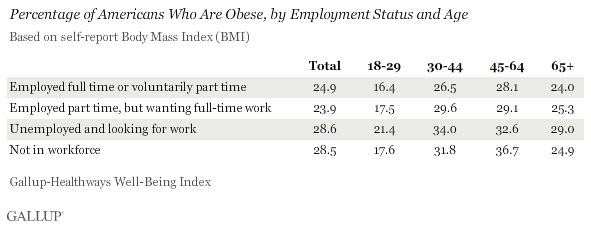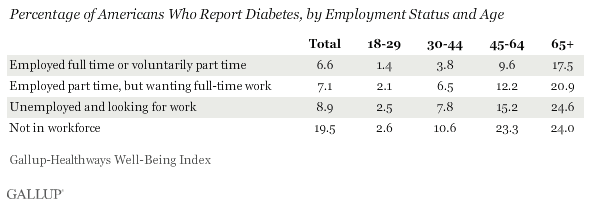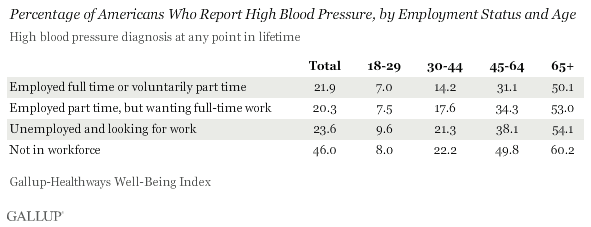WASHINGTON, D.C. -- Americans who are employed full time or voluntarily part time enjoy better physical health than those who are unemployed or have less work than they would like. However, those who are not in the workforce at all report the worst health. Employed Americans have a score of 81.4 on the Gallup-Healthways Physical Health Index, compared with 76.1 among those who are employed part time but seeking full-time work, 75.2 for those who are unemployed, and 68.8 for those who are not in the workforce.

Employed Americans in every age group report better physical health than do those who are underemployed or those who are not in the workforce, particularly among those between the ages of 30 and 64.
Those not in the workforce -- meaning they are not employed and not actively seeking employment -- have the worst physical health overall. While this is partly due to most of these individuals being of retirement age, even among seniors, those who are working report better health than their counterparts who are not. This pattern holds among those between the ages of 30 and 44 as well as those aged 45 to 64, and may be, in part, due to those who have lost or cannot hold work due to poor health and have now stopped seeking employment.
The Physical Health Index, one of six sub-components of the Gallup-Healthways Well-Being Index, includes 18 items that measure: sick days in the past month, disease burden, health problems that get in the way of normal activities, obesity, feeling well-rested, daily energy, daily colds, daily flu, and daily headaches.
Obesity, Diabetes Higher Among the Unemployed
Unemployed Americans are much more likely than those who are employed to be obese. Additionally, they are even more likely to be obese than those who are working part time but looking for a full-time job.
Those aged 18 to 44 who are unemployed are doing particularly poorly -- they are about 30% more likely to be obese than are their employed counterparts.

Diabetes, which is linked to obesity, follows a similar pattern. Americans of all ages who are unemployed are slightly more likely to report having ever been diagnosed with diabetes than are those who are employed. However, Americans of all ages who are not in the workforce are more likely report a diabetes diagnosis than are their working counterparts. Overall, those who are not in the workforce are nearly three times more likely to have been diagnosed in their lifetimes with diabetes than are employed workers, in large part because older Americans disproportionately make up the group of those who are not in the workforce

Unemployed, Those Not in the Workforce More Likely to Have High Blood Pressure
High blood pressure, which like diabetes is linked to obesity, is also more prevalent among the unemployed than the employed. This is true across all age groups. For example, unemployed Americans aged 30 to 44 are 50% more likely than those who are employed to report having ever received a high blood pressure diagnosis.
But, those not in the workforce are even more likely than the unemployed to say they have ever been diagnosed with high blood pressure. Again, this is true across all age groups. Nearly one-half of those aged 45 to 64 who are not in the workforce report high blood pressure compared with less than one-third of those who are employed.

Asthma Also Higher Among the Unemployed
Unemployed Americans are 57% more likely to report that they have ever been diagnosed with asthma than are those who are employed. In fact, unemployed Americans of all ages are more likely than the employed to report asthma. Asthma is particularly high among unemployed adults aged 18 to 29, with nearly one out of every five reporting the condition.
Those who are not in the workforce and those who are employed part time, but are seeking a full-time job, are about as likely to report an asthma diagnosis as are the unemployed.

Importantly and perhaps related, Gallup has also found that unemployed Americans of all ages are much more likely to smoke than are those who are employed
Implications
As U.S. employers increasingly emphasize well-being as a means of lowering turnover, decreasing absenteeism, increasing productivity, and reducing healthcare costs, it is possible that having a job may be playing an increasingly positive role in the physical health of American adults. It is also possible that some employers may shy away from extending employment opportunities to those who have poor physical health for the same reasons.
Still, demographics most certainly play a role. For example, the unemployed will ordinarily have lower income levels than those who are employed and there is a clear relationship between physical health and income. Those who are unemployed are also more likely to have lower levels of education, which may mean they have lower levels of health literacy and fewer opportunities to enhance their physical health.
Ultimately, both scenarios are likely viable: those with a job are more likely to maintain better physical health, and those with better physical health are more likely to get and keep a job. This is significant, as chronic health conditions are estimated to cost U.S. employers $153 billion per year in absenteeism alone. That work and physical health are linked is another good reason to pursue them both.
About the Gallup-Healthways Well-Being Index
The Gallup-Healthways Well-Being Index tracks well-being in the U.S., U.K., and Germany and provides best-in-class solutions for a healthier world. To learn more, please visit well-beingindex.com.
Survey Methods
Results are based on telephone interviews conducted as part of the Gallup-Healthways Well-Being Index survey Jan. 2, 2011-May 21, 2012, with a random sample of 474,195 adults, aged 18 and older, living in all 50 U.S. states and the District of Columbia, selected using random-digit-dial sampling. Of this sample, fully employed respondents comprised the majority (51.8%), with about 5% each for part-time employees and the unemployed who are looking for work.

For results based on the various age groups for each category of work, one can say with 95% confidence that the maximum margin of sampling error ranges from ±2.0 percentage points for the smallest groups to ±0.3 percentage points for the largest groups.
Interviews are conducted with respondents on landline telephones and cellular phones, with interviews conducted in Spanish for respondents who are primarily Spanish-speaking. Each sample includes a minimum quota of 400 cell phone respondents and 600 landline respondents per 1,000 national adults, with additional minimum quotas among landline respondents by region. Landline telephone numbers are chosen at random among listed telephone numbers. Cell phone numbers are selected using random-digit-dial methods. Landline respondents are chosen at random within each household on the basis of which member had the most recent birthday.
Samples are weighted by gender, age, race, Hispanic ethnicity, education, region, adults in the household, and phone status (cell phone only/landline only/both, cell phone mostly, and having an unlisted landline number). Demographic weighting targets are based on the March 2010 Current Population Survey figures for the aged 18 and older non-institutionalized population living in U.S. telephone households. All reported margins of sampling error include the computed design effects for weighting and sample design.
In addition to sampling error, question wording and practical difficulties in conducting surveys can introduce error or bias into the findings of public opinion polls.
For more details on Gallup's polling methodology, visit https://www.gallup.com/.
